I am building a flash game that requires correct pathfinding. I used the pseudo code in this tutorial and a diagonal heuristic. I did not closely follow their code. The language is ActionScript 3 and I am also using flashpunk libraries.
My current issue is that the program is producing a path that is clearly not the shortest path possible. Here is a screenshot showing the problem:

The grey blocks are non traversable, the green blocks mark nodes that have been "visited" and the blue blocks show the path generated by the algorithm.
It looks as if the diagonal travel cost is equal to the non-diagonal travel cost, despite my attempt to make the diagonal cost higher (1.414).
This is the overall algorithm implementation.
function solveMaze() {
// intitialize starting node
startingNode.g = 0;
startingNode.h = diagonalHeuristic(startingNode, destinationNode);
startingNode.f = startingNode.g + startingNode.h;
// Loop until destination node has been reached.
while (currentNode != destinationNode) {
if (openNodes.length == 0) {
return null;
}
// set lowest cost node in openNode list to current node
currentNode = lowestCostInArray(openNodes);
//remove current node from openList
openNodes.splice(openNodes.indexOf(currentNode), 1);
//find 8 nodes adjacent to current node
connectedNodes = findConnectedNodes(currentNode);
//for each adjacent node,
for each (var n:Node in connectedNodes) {
// if node is not in open list AND its not in closed list AND its traversable
if ((openNodes.indexOf(n) == -1) && (closedNodes.indexOf(n) == -1) && n.traversable) {
// Calculate g and h values for the adjacent node and add the adjacent node to the open list
// also set the current node as the parent of the adjacent node
if ((n.mapX != currentNode.mapX) && (n.mapY != currentNode.mapY)) {
cost = 1.414;
} else {
cost = 1;
}
if(n.g> currentNode.g + cost){
n.g = currentNode.g + cost;
n.f=calculateCostOfNode(n);
n.parentNode =currentNode;
openNodes.push(n);
}
}
}
// turn current node into grass to indicate its been traversed
currentNode.setType("walked_path");
//var temp2:TextEntity = new TextEntity(n.h.toFixed(1).toString(), 32 * currentNode.mapX, 32 * currentNode.mapY);
//add(temp2);
// add current node to closed list
closedNodes.push(currentNode);
}
// create a path from the destination node back to the starting node by following each parent node
var tempNode:Node = destinationNode.parentNode;
tempNode.setType("path2"); // blue blocks
while(tempNode != startingNode){
tempNode = tempNode.parentNode;
tempNode.setType("path2");
}
}
These were the helper functions used:
function findConnectedNodes(inputNode:Node):Array {
var outputArray:Array=[];
// obtain all nodes that are either 1 unit away or 1.4 units away.
for each (var n:Node in listOfNodes){
if ((diagonalHeuristic(inputNode, n) == 1)||(diagonalHeuristic(inputNode, n) == 1.4) {
outputArray.push(n);
}
}
return outputArray;
}
public static function diagonalHeuristic(node:Node, destinationNode:Node, cost:Number = 1.0, diagonalCost:Number = 1.4):Number {
var dx:Number = Math.abs(node.mapX - destinationNode.mapX);
var dy:Number = Math.abs(node.mapY - destinationNode.mapY);
if (dx > dy) {
return diagonalCost * dy + (dx - dy);
}else {
return diagonalCost * dx + (dy - dx);
}
}
function lowestCostInArray(inputArray:Array):Node {
var tempNode:Node = inputArray[0];
for each (var n:Node in inputArray) {
if (n.f < tempNode.f) {
tempNode = n;
}
}
return tempNode;
}
I can provide the project source code if it would help.